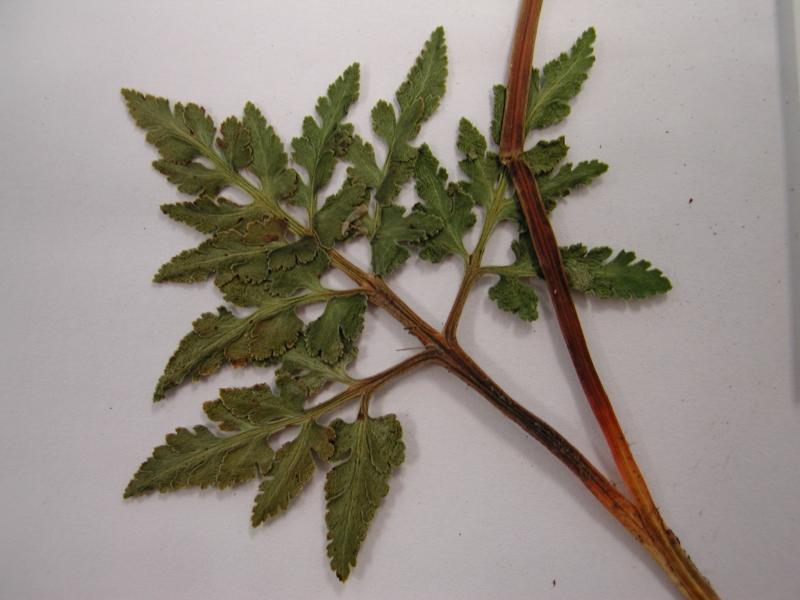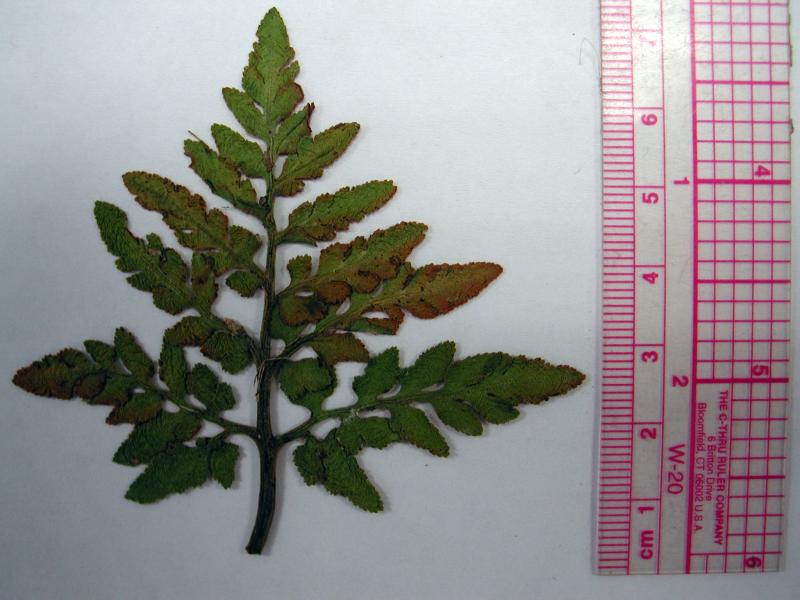Rugulose Grape Fern
Botrychium rugulosum W.H. Wagner
- Class
- Ophioglossopsida
- Family
- Ophioglossaceae (adder's-tongue family)
- State Protection
- Endangered
Listed as Endangered by New York State: in imminent danger of extirpation in New York. For animals, taking, importation, transportation, or possession is prohibited, except under license or permit. For plants, removal or damage without the consent of the landowner is prohibited.
- Federal Protection
- Not Listed
- State Conservation Status Rank
- S1
Critically Imperiled in New York - Especially vulnerable to disappearing from New York due to extreme rarity or other factors; typically 5 or fewer populations or locations in New York, very few individuals, very restricted range, very few remaining acres (or miles of stream), and/or very steep declines.
- Global Conservation Status Rank
- G3
Vulnerable globally - At moderate risk of extinction due to rarity or other factors; typically 80 or fewer populations or locations in the world, few individuals, restricted range, few remaining acres (or miles of stream), and/or recent and widespread declines.
Summary
Did you know?
This fern often occurs in the company of other similar-looking grapeferns. If many individuals are seen in one population they must be carefully examined to identify separate species. The species name comes from the Latin "ruga", meaning wrinkled, and refers to the wrinkled surface of the leaf.
State Ranking Justification
There are two existing populations with only one to a few plants in each population. There are eight historical populations but none of them has been seen since the late 1940s.
Short-term Trends
It is very difficult to ascertain a short-term trend since populations are small and plants do not appear every year.
Long-term Trends
This fern was never common in the state but changes in agricultural use and habitat development have probably resulted in a decrease in populations. None of the historical populations have been rediscovered and only two new populations are known.
Conservation and Management
Threats
This fern appears to be stimulated by grazing so changes in grazing patterns and subsequent succession could threaten populations. Suburban development south of Oneida Lake has reduced available habitat.
Conservation Strategies and Management Practices
Grazing and other disturbance patterns need to be maintained around existing populations to prevent succession from changing the open habitat that this fern requires.
Research Needs
Long-term demographic studies need to be undertaken on existing populations to better understand trends and variation.
Habitat
Habitat
This fern is found in old pastures, lightly grazed areas, meadows, and successional northern hardwood forests (New York Natural Heritage Program 2006). In open fields and secondary forests over wide range in vicinity of St. Lawrence Seaway (Flora of North America 1993). Actively pastured open fields and meadows (Wagner and Wagner 1982).
Associated Ecological Communities
- Alvar pavement grassland*
(guide)
This community consists of exposed, flat limestone or dolostone pavement with grassy or mossy patches interspersed throughout. Some examples may be solely grassland with no pavement.
- Pastureland
Agricultural land permanently maintained (or recently abandoned) as a pasture area for livestock.
- Successional northern hardwoods
A hardwood or mixed forest that occurs on sites that have been cleared or otherwise disturbed. Canopy trees are usually relatively young in age (25-50 years old) and signs of earlier forest disturbance are often evident. Characteristic trees and shrubs include any of the following: quaking aspen, big-tooth aspen, balsam poplar, paper birch, gray birch, pin cherry, black cherry, red maple, and white pine.
- Successional old field
A meadow dominated by forbs and grasses that occurs on sites that have been cleared and plowed (for farming or development), and then abandoned or only occasionally mowed.
- Successional red cedar woodland*
A woodland community that commonly occurs on abandoned agricultural fields and pastures, usually at elevations less than 1000 ft (305 m). The dominant tree is eastern red cedar, which may occur widely spaced in young stands and may be rather dense in more mature stands.
* probable association but not confirmed.
Associated Species
- Botrychium dissectum (dissected grapefern)
- Botrychium matricariifolium (daisy-leaved moonwort)
- Comptonia peregrina (sweet-fern)
- Danthonia compressa (northern oat grass)
- Dennstaedtia punctilobula (hay-scented fern)
- Fragaria virginiana
- Juniperus virginiana
- Pinus strobus (white pine)
- Prunella vulgaris
- Pteridium aquilinum var. latiusculum
- Rubus idaeus ssp. idaeus (European red raspberry)
- Spiraea alba var. alba (narrow-leaved meadow-sweet)
- Spiraea tomentosa var. tomentosa
Range
New York State Distribution
Three historical records can be found in an area from southern Oneida Lake to Syracuse and Utica. Four other historical records were found in an area around Parishville, St. Lawrence County. Existing records can be found in St. Lawrence County and in the Adirondacks in Hamilton County.
Global Distribution
This fern is limited to the St. Lawrence Seaway and Great Lakes regions. This range extends from northern Vermont and southern Quebec through northern New York, southern Ontario, much of Michigan, northern Wisconsin, and northeastern Minnesota. Reports from Connecticut are likely erronous.
Identification Comments
General Description
Rugulose grape fern is a perennial, evergreen fern. The common leaf stem of the fertile and sterile segments is up to 6 inches long while the leaf stem of the more erect fertile segment can be up to 9 inches long. This spore-bearing portion of the leaf can be up to 5 1/2 inches long. The leaf stem of the sterile leaf can be up to 3 inches long. The sterile leaf blade appears in the middle of May, is green, and grows up to 6 inches long and 10 inches wide. It is divided into two or three broadly triangular leaflets (pinnae). The terminal pinna blade is egg shaped to triangular in outline and the same size as the lateral pinnae. The pinnae are again divided into pinnules which are divided into segments. The terminal pinna are divided into progressively smaller segments up to the tips. The ultimate segments of the pinnules are angular trowel shaped to spoon shaped. The edges have somewhat rounded, wide teeth The upper surface of the leaf is convex and wrinkled when alive. The leaves remain green throughout the winter where they are exposed.
Identifying Characteristics
Rugulose grape fern is a perennial, evergreen fern. The common petiole of fertile and sterile segments 2-15 cm long. Petiole of erect fertile segment to 22 cm long, sporophyll to 14 cm long. Petiole of the sterile leaf 4-8 cm long. Sterile leaf blade 4-8 cm long and 26 cm wide, appearing in midspring, divided into two or three broadly triangular pinnae. Terminal and lateral pinnae ovate-deltoid and about the same size, pinnules rhomboidal, ovate, or oblong, usually strongly angled, and more or less divided into segments to the tips. Ultimate pinnule segments obliquely and angularly trowel shaped to spatulate, margins with nearly regular, somewhat rounded, wide teeth. Leaf surface in the living state convex above and more or less coarsely rugulose. Leaves remain green throughout the winter where they are exposed.
Best Life Stage for Proper Identification
This can be a difficult to identify fern. With only a few individuals typically present, we do not want to encourage collection. Instead, to obtain verification of the identity, please take a few photographs of the plant and collect just a portion of the leaf frond.
Similar Species
In Botrychium dissectum and Botrychium oneidense the terminal pinna is larger than the lateral pinnae. The pinnules of the terminal pinna are more or less undivided at the tips and are flat and smooth. Botrychium oneidense is usually only found in low shaded forests and swamps where Botrychium rugulosum is found in open habitats. The long stalked pinnae and rather large space between the basal pair of pinnae and the upper pairs will distinguish this species from B. lunarioides and B. multifidum. Botrychium multifidum has pinnules that are rounded, larger and mostly 4-8 mm wide. The leaf surface is flat and without wrinkles. The edges of the ultimate segments of the pinnules have rounded teeth or are smooth. New leaves appear in early May. Botrychium rugulosum closely resembles its Asiatic counterpart, B. ternatum, to such an extent that they were considered the same species until 1982, when Wagner and Wagner (1982) determined that true B. ternatum did not occur in North America.
Best Time to See
Leaves for this fern emerge mid-May and fruit develops mid-August through September. This fern can be identified vegetatively, so surveys may be conducted at any point during the growing season.
- Vegetative
- Fruiting
The time of year you would expect to find Rugulose Grape Fern vegetative and fruiting in New York.
Rugulose Grape Fern Images
Taxonomy
Rugulose Grape Fern
Botrychium rugulosum W.H. Wagner
- Kingdom Plantae
- Phylum Filicinophyta
- Class Ophioglossopsida
- Order Ophioglossales
- Family Ophioglossaceae (adder's-tongue family)
- Order Ophioglossales
- Class Ophioglossopsida
- Phylum Filicinophyta
Synonyms
- Botrychium ternatum auct. non (Thunb.) Sw.
Additional Resources
Best Identification Reference
Flora of North America Editorial Committee. 1993. Flora of North America, North of Mexico. Volume 2. Pteridophytes and Gymnosperms. Oxford University Press, New York. 475 pp.
Other References
Gleason, Henry A. and A. Cronquist. 1991. Manual of Vascular Plants of Northeastern United States and Adjacent Canada. The New York Botanical Garden, Bronx, New York. 910 pp.
Holmgren, Noel. 1998. The Illustrated Companion to Gleason and Cronquist's Manual. Illustrations of the Vascular Plants of Northeastern United States and Adjacent Canada. The New York Botanical Garden, Bronx, New York.
Lellinger, David B. 1985. A Field Manual of the ferns and fern-allies of the United States and Canada. Smithsonian Institution, Washington, D.C. 389 Pp.
New York Natural Heritage Program. 2010. Biotics database. New York Natural Heritage Program. New York State Department of Environmental Conservation. Albany, NY.
New York Natural Heritage Program. 2024. New York Natural Heritage Program Databases. Albany, NY.
Wagner, W.H. 1959. American Grapeferns Resembling Botrychium Ternatum: A Preliminary Report. American Fern Journal 49:97-103.
Wagner, W.H. Jr. and F.S. Wagner. 1982. Botrychium rugulosum (Ophioglossaceae), a Newly Recognized Species of Evergreen Grape fern in the Great Lakes Area of North America. Contr. Univ. Mich. Herb. 15:315-324.
Weldy, T. and D. Werier. 2010. New York flora atlas. [S.M. Landry, K.N. Campbell, and L.D. Mabe (original application development), Florida Center for Community Design and Research http://www.fccdr.usf.edu/. University of South Florida http://www.usf.edu/]. New York Flora Association http://newyork.plantatlas.usf.edu/, Albany, New York
Weldy, Troy W. and David Werier. 2005. New York Flora Atlas. [S.M. Landry, K.N. Campbell, and L.D. Mabe (original application development), Florida Center for Community Design and Research. University of South Florida]. New York Flora Association, Albany, NY. Available on the web at (http://newyork.plantatlas.usf.edu/).
Links
About This Guide
Information for this guide was last updated on: April 18, 2006
Please cite this page as:
New York Natural Heritage Program. 2024.
Online Conservation Guide for
Botrychium rugulosum.
Available from: https://guides.nynhp.org/rugulose-grape-fern/.
Accessed July 27, 2024.

